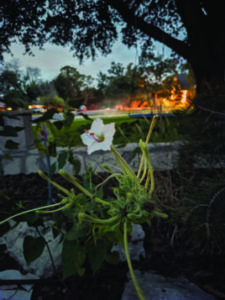By Debbie Roland and
Emmy Ulmschneider
Master Gardeners
Did you know that there are plants that will grow here and that also bloom at night? They are referred to as “night flowers” and “moon flowers” and their blooming length can vary from one night to every night of the season. And after a hot West Texas day there is no better feeling than to step outside into a cool West Texas night and enjoy the fragrance and beauty of night bloomers. They draw bats and moths with their beautiful colors and sweet smells and provide a great aesthetic to an evening on your patio.
Evening Primrose is an east Texas native, produces large yellow flowers that bloom from July to September. The blooms can be pink, white or yellow. O. biennis has yellow flowers. O speciosa has pink to white flowers and in our area blooms open in evening and close in the morning. It is a biennial which means it will establish its stem and leaves the first year, flower the second year and then die. It attracts moths, birds eat the seeds, and small mammals will eat the roots and leaves of young plants.

Sweet Four O’Clock (Mirabilis longiflora) is named for the time of day that the blooms open. The flower is pinkish with a magenta throat which spreads into a white flower plus you get a sweet smell. Their pollinators, hawk moths have some of the longest tongues in the moth world to pollinate these flowers.
Chocolate Daisy (Berlandiera lyrata) is a night blooming, drought tolerant, West Texas perennial native to shortgrass prairies. Flowers wilt in the morning so be sure to catch the heavenly chocolate scent while it is most noticeable. It blooms April to November but in frost free areas it can bloom year-round. It is a nectar source particularly for butterflies. This flower can grow to 2’ in height and has yellow petals that circle a central disk. Once the yellow ray petals fall off the green calyces remain and surround the disc, hence its other common name green eyes. The seeds develop from the pollinated disc flowers. As they mature, they and the calyces dry out they and remain attached making the seeds very easy to harvest. Chocolate Daisy easily self-sows or you can spread the seeds yourself wherever you want this hardy drought tolerant easy to care for plant.
For more information, call the AgriLife office at 498-4071 in Odessa or at 686-4700 in Midland or visit aggie-horticulture.tamu.edu or westtexasgardening.org.




